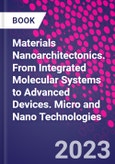Materials Nanoarchitectonics: From Integrated Molecular Systems to Advanced Devices provides the latest information on the design and molecular manipulation of self-organized hierarchically structured systems using tailor-made nanoscale materials as structural and functional units. The book is organized into three main sections that focus on molecular design of building blocks and hybrid materials, formation of nanostructures, and applications and devices. Bringing together emerging materials, synthetic aspects, nanostructure strategies, and applications, the book aims to support further progress, by offering different perspectives and a strong interdisciplinary approach to this rapidly growing area of innovation.
This is an extremely valuable resource for researchers, advanced students, and scientists in industry, with an interest in nanoarchitectonics, nanostructures, and nanomaterials, or across the areas of nanotechnology, chemistry, surface science, polymer science, electrical engineering, physics, chemical engineering, and materials science.
Please Note: This is an On Demand product, delivery may take up to 11 working days after payment has been received.
Table of Contents
1. Nanoarchitectonics: A Land of Opportunities
2. Nitrogen functionalities assisted nanoporous carbon materials for supercapacitor studies
3. Membrane nanoarchitectonics: advanced nanoporous membranes for osmotic power generation
4. Biointerfacial nanoarchitectonics: layer-by-layer assembly as a versatile technique for the fabrication of highly functional nanocoatings of biological interest
5. Charged porphyrins as building blocks of ?-electronic ion-pairing assemblies
6. Layered structures in soft nanoarchitectonics: towards functional photonic materials
7. Metal Nanoarchitectonics: Fabrication of Sophisticated Gold Nanostructures for Functional Plasmonic Devices
8. Molecular Imprinting as Key Technology for Smart Nanoarchitectonics
9. Self-assembled structures as emerging cellular scaffoldses
10. 2D materials-based nanoarchitectonics for metal-ion batteries
11. Thin film nanoarchitectonics via Langmuir-Blodgett and layer-by-layer methods
12. Langmuir films
a universal method for fabricating organized monolayers from nanomaterials
13. MXenes and their applications in sensors
14. Composite materials based on mesoporous oxides and noble metal nanoparticles
15. Nanoarchitectonics of Metal-Organic Frameworks (MOFs) for energy and sensing applications
16. Ionic nanoarchitectonics for nanochannel-based biosensing devices
17. Molecular, supramolecular, and macromolecular engineering at hybrid mesoporous interfaces: choose your own nanoarchitectonic adventure
18. Nanomaterials and catalysis
19. Design of supramolecular chemosensor arrays and their applications to optical chips
20. 3D graphene fabrication and application for energy storage systems








